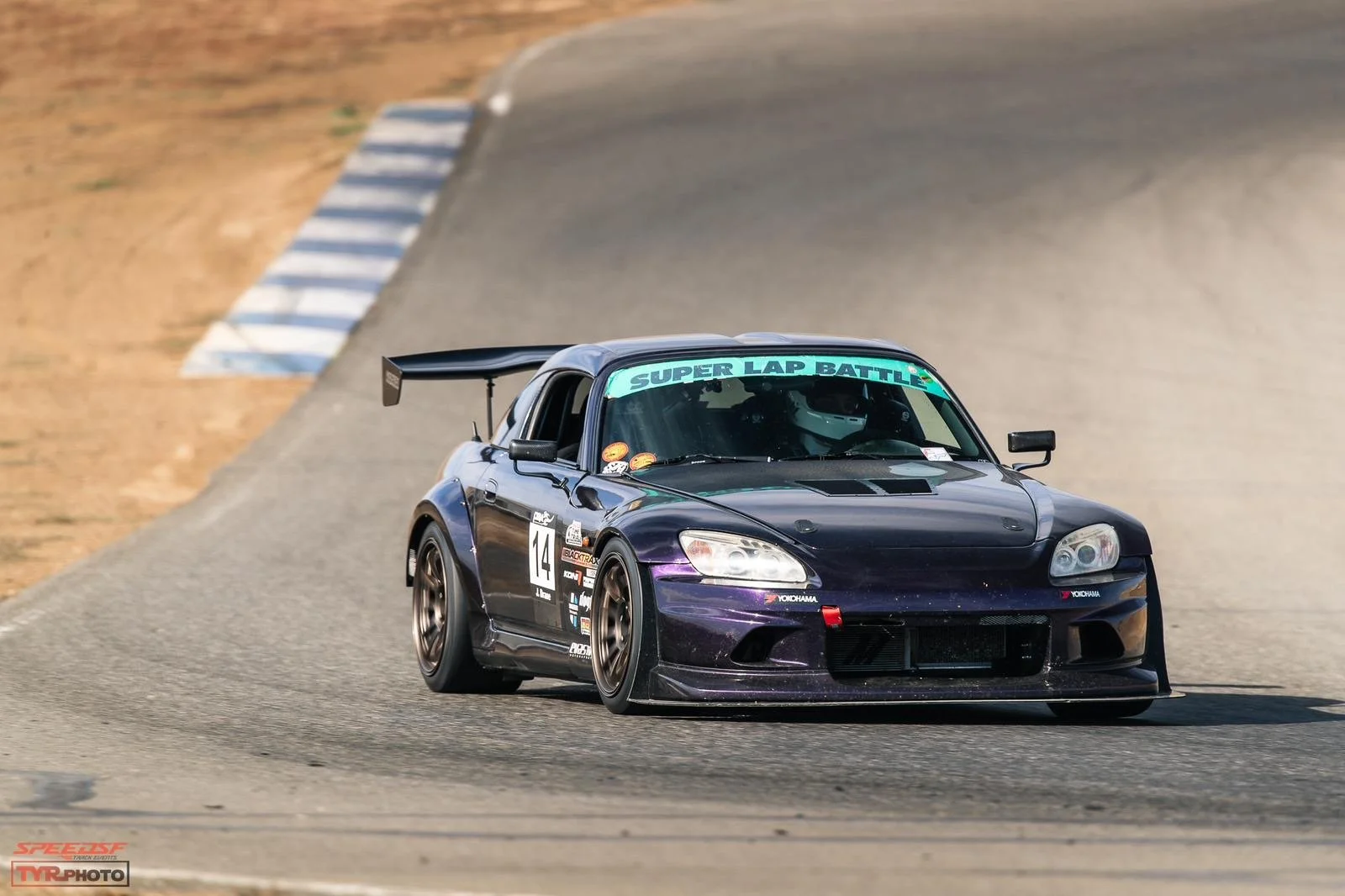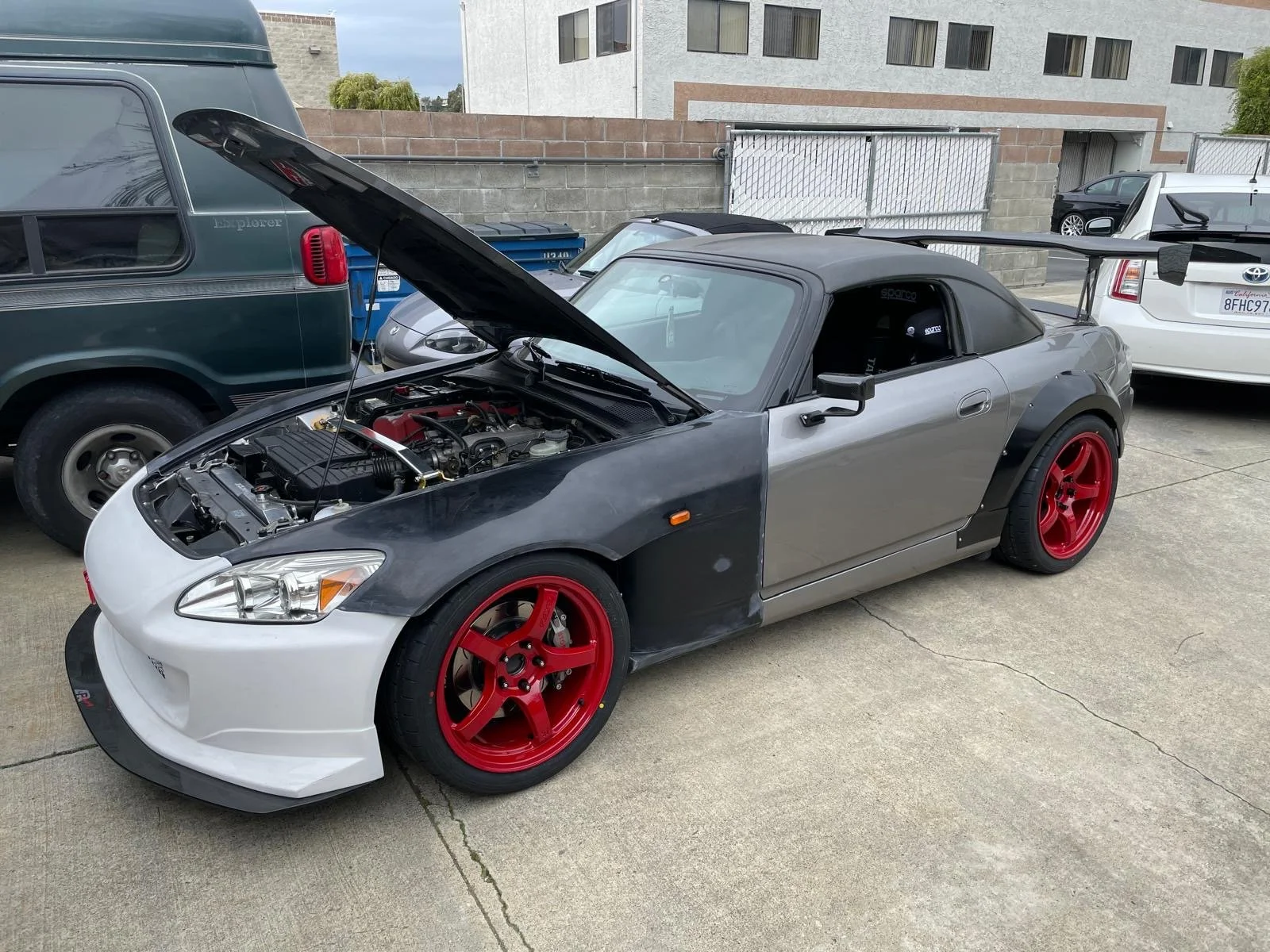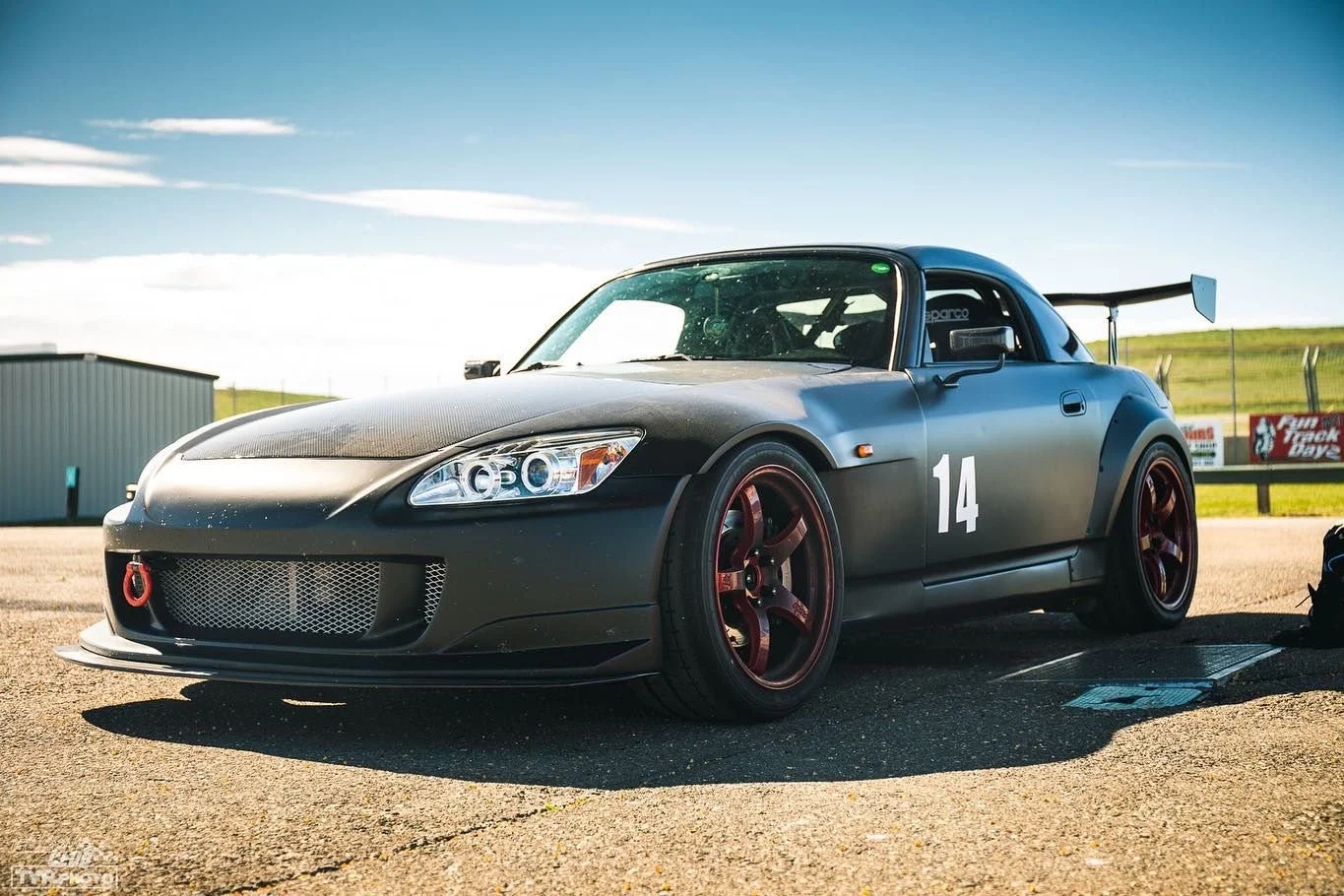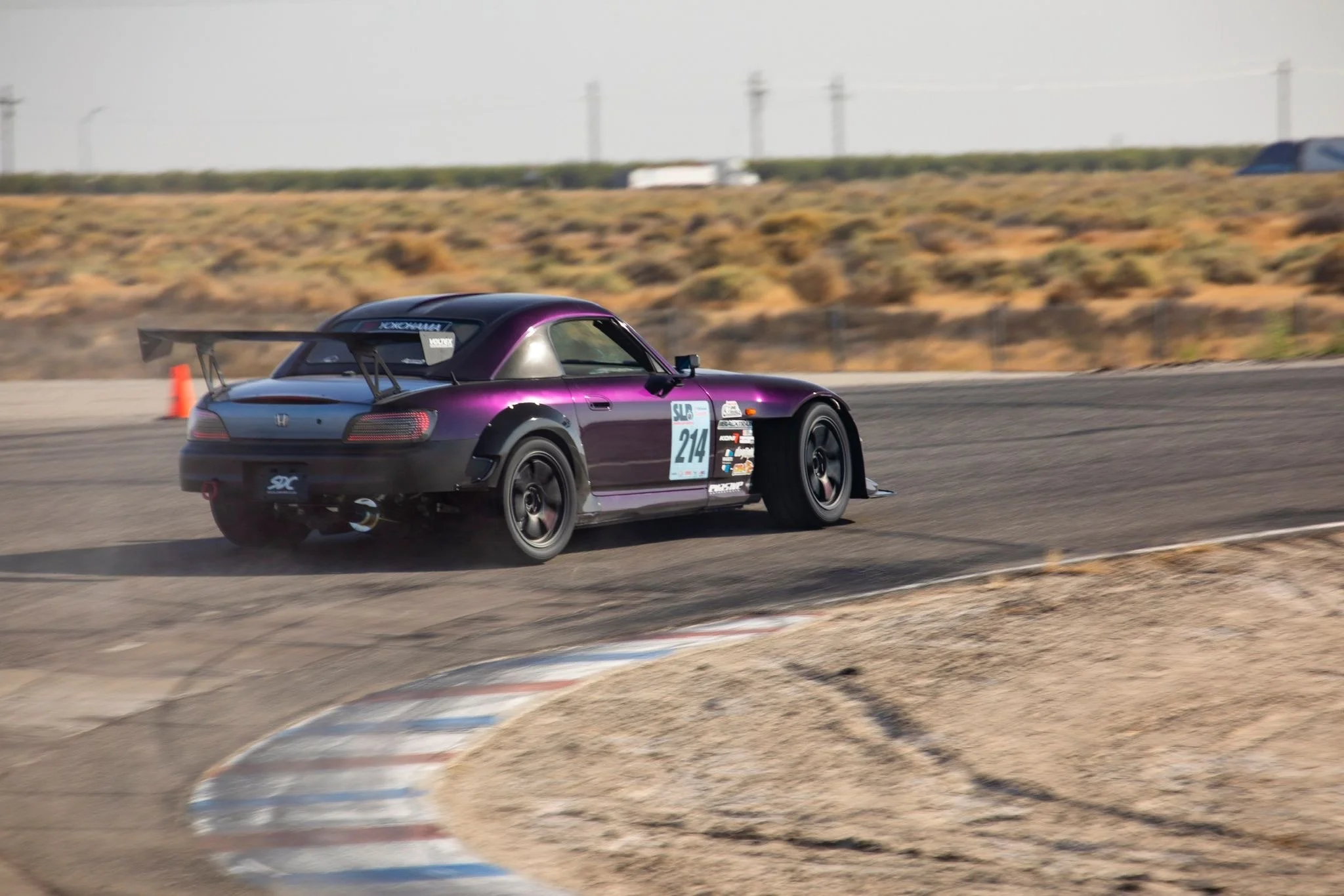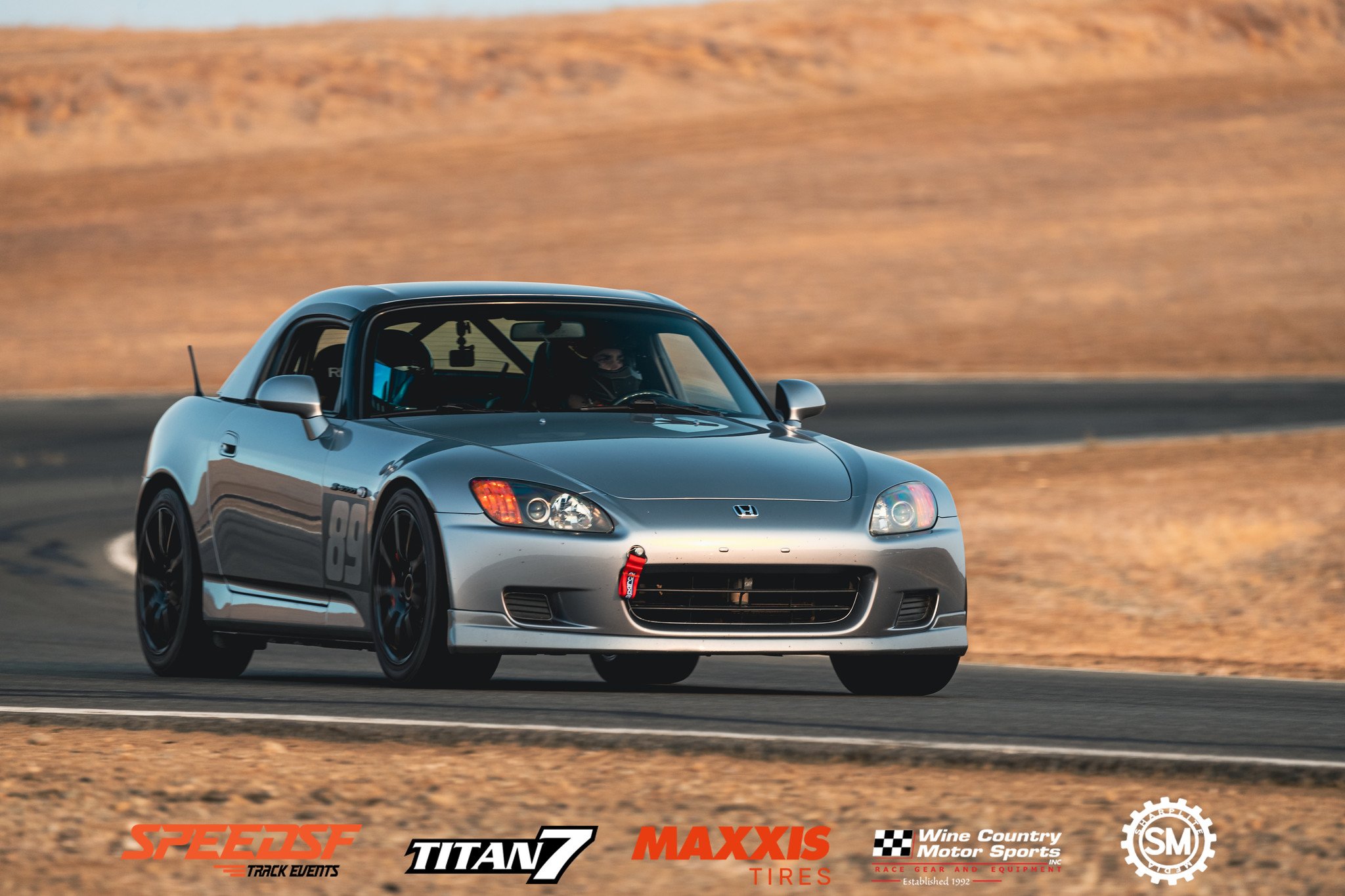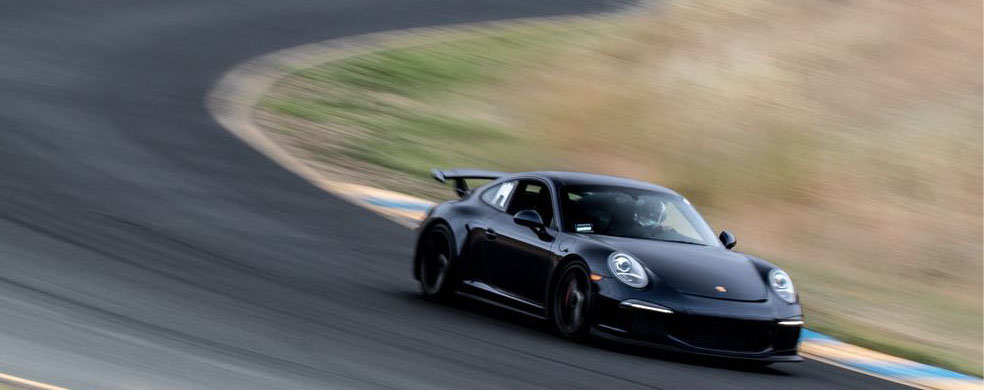
Joe’s AP1 S2000: Continuing Education
A couple years before forty, Joe Drane decided to finally give track days a try. Like with everything he’s pursued, he dove in with two feet and built a stunning S2000 in record time.
It wasn’t until Joe Drane moved out to California at the ripe age of 38 that he was able to try track driving for himself. Being a natural tinkerer and a bit of a hot rodder growing up, track driving had been a lifelong dream, but the opportunities for that sort of thing in rural Florida were few and far between.
After teaching him the ins and outs of network engineering, Joe started learning the cloud and found a few roles with startups in Texas. This created a focus on execution and continuous learning while also placing high value in data helped him put together a stellar resume in short time. This almost obsessive approach would later help Joe learn at a ridiculously rapid rate when learning the racing ropes.
The Land of Milk and Honey
After relocating to San Francisco to start a new role with Facebook, the assortment of beautiful sports cars lining the streets suggested he might be in the right place to learn to drive on track. He searched for ins on the pages of the local sanctioning bodies until he found an easier, more cost-effective way to dip his toe in the water.
Meanwhile, the need for a new outlet was getting harder to ignore. COVID weighed heavily on him, and while he loved his new job, it didn’t offer the distraction he needed mid-pandemic.
When he proposed running a few lapping days one weekend, his wife not only supported him in his decision, she helped him find an appropriate track car. Incidentally, the two had met at work after Joe spotted her leaving her S2000 in the parking lot. It only seemed right that such a car, the conversation starter, would help him start another love affair.
And so he picked out the cheapest first-gen S2000 he could find. This was several years ago, but even by the standards of the time, this car was affordable — and for good reason. “It was just a mess. It had no rear glass, the check engine light was on, the wiring was a rat’s nest, and the motor was ticking. I spent the winter restoring it, but I didn’t realize just how bad things were until I started working on it.”
Growing Pains
“I ran into some issues installing the aftermarket parts. The radiator wasn’t sitting low enough for the hood to close. I took it into the shop at BlackTrax to have it inspected, and there the mess continued to unfold. The radiator supports were bent, and I couldn’t purchase new ones anymore. I had to source the brackets from two fender cutouts from eBay.
Then we pulled the cylinder head and saw the valve retainers were cracked, there was a ton of carbon on the valves, and two of the cylinder walls were scarred. After ten track days, the transmission blew third gear. Oh man, what a nightmare it was.”
To mend the ailing engine and fortify it for track use, he replaced the block with rebuilt F22’s, then fitted a Radium catch can as well as Mishimoto’s radiator and oil cooler. Not eager to deal with another blown F-series, he wisely spent a few thousand more on a Link G4+ ECU to employ several failsafes and extract everything from the motor — mainly more mid-range torque and a peak of 227 horsepower at the wheels.The Link was then paired to an AiM MXG dash which to give him alerts and relay lap data.
Despite the early hurdles he had to cover, he remained willing and able to push on. The obsessive drive which fueled Joe’s career now had a second outlet; allowing him to research the engineering involved, pick parts, test them on track, and build a more supportive social network than the one which work provided him.
As it gave him a new lease on life, he didn’t hesitate to spend whatever was needed to turn this rough example of an S2000 into something exceptional. Within a few months, he’d added a long list of modifications to try and breathe some new life into this aging chassis.
After investing so much in the performance side of things, it made sense to apply an Inozetek wrap to help the car pop.
Among those additions were an APR splitter, a Voltex Type II wing, Rockstar Garage’s Feal two-way coilovers, and Stoptech C43 (F) and C42 big (R) brakes. Studying hours of onboard footage — namely Nate Hackman’s banzai laps — helped him understand just how much harder he could apply the brakes and how severely late he was getting to throttle.
In the interest of getting up to speed quickly, he skipped the cheap tires and went straight to a set of Yokohama Advan A052s, then wrapped them around a set of 18 x 9.5” Advan Gram Lights.
Though he’d already spent a small fortune on parts, never once did Joe agonize over expense during this introductory period. “I decided to pay for an education in racing since I feel it usually pays dividends,” he said. When his engine tuner Jei from BlackTrax offered to tag along to one HPDE at Thunderhill and teach Joe to study data, he jumped at the opportunity. “The telemetry revealed I was shifting a little too much, so we figured out the right shift points and instantly cut a couple seconds off my PB.”
The car was capable and reassuring enough for Joe to continue pushing, but asking more the car led to the standard Torsen differential failing. In its place, Joe put a Puddymod 1.5-way OSG and found the incremental improvement in power-down and stability motivating enough to invest in one other area that wasn’t quite up to snuff: dampers.
Joe knew the top-shelf option would make the car more quicker, more predictable, and less taxing to drive, so he splurged on a set of Blacktrax-built Penske 8300s. Even without much knob turning, the new dampers revitalized the car and helped Joe find the confidence to commit to the quick corners. “My favorite mod, without question. I dropped six seconds off my previous best the first time out on the Penskes. Worth every penny.”
Continuing Education
Learning to wrench and approach the track from a theoretical perspective helped him progress, but never having attended a racing school, he started to wonder if there were ways to improve his technique post-haste. He enrolled in a few drift courses to study the art of oversteering, and soon felt at ease asking the S2000 to rotate a little more than before.
Both his approach and the S2000’s setup are far from perfect, and Joe’s wise enough to admit that. “I haven’t thought much about adjusting the dampers — most of the time I just leave them in a neutral position and try to drive as best as I can.”
But the results from a relatively short time spent on track speak for themselves. He’s learned at a remarkable rate and, with a little more guidance from the knowledgeable group of friends he’s made recently, he’s bound to be fighting for podiums at the front of the S3 class sometime soon. He still has a few points to play with — and they’ll go towards a Zebulon rear wing, a larger Alumalite splitter, and Professional Awesome tunnels.
Joe’s studious nature has also helped him better understand the endless tradeoffs that building a track car requires. While the major cost associated with getting a rough car off the ground can eat into an aspiring driver’s budget, the peace of mind that comes from driving a flawed, imperfect car can help a driver push hard — harder than they likely would in a pristine example. That’s why he has no regrets taking the rocky but fruitful and informative path he took.
Alex's AP1 S2000: Earning His Spurs
Tempted to try something livelier than his DC1, Alex bought himself an AP1 S2000 a few years back and learned how lively it really was. He chose his modifications with the aim of making it reliable and predictable, and in doing so, built a foundation upon which he could learn his craft.
Though this AP1 wasn’t Alex Caruso’s first track car, it was the car with which he truly earned his spurs. A few years before buying this car, he got his feet wet with an NA Miata, then later an Integra GSR. Thesef two taught him about car control and patience with the right foot, but they lost their appeal with time. Eventually, he wanted to try something a bit more exhilarating. By then, Alex was no longer a student just scraping by, and he had a little more to spend on a special sort of car.
When this car popped up in his feed, he immediately checked his bank balance. Hardtop, great paint, totally stock, and basically a blank slate with which he could express his creative streak. There was one problem, though: he couldn’t quite afford it. Undeterred, Alex committed to finding the money. With the help of his supportive wife, he scraped together enough for a down payment and brought it home.
Not long after, he started leafing through those old lists of dream parts he’d scrawled away when he was a daydreaming, broke college kid. The first round of mods were intended to make the motor indestructible. Because the ‘01 models didn’t receive the piston-cooling oil squirters the following year’s motor did, he retrofitted those to fit his motor, careful not to crossthread anything down there. Following that, he added AP2 valve retainers, then sent his valve covers out to be drilled; the AP1’s valve covers need to be perforated to help move some of the blowby.
Though these drilled valve covers works with the stock PCV system, Alex added a catch can—one which doesn’t need emptying until the fifth track day.
With the powertrain bulletproofed, he started running his car to the 9,000-rpm redline and enjoying the honeymoon phase, spins and all. The AP1’s nervousness was thrilling, challenging, and hugely educational—even if he had to clean plenty of grass out of his wheel wells. “Once I started pushing, I looped that thing so many times,” he laughed.
Though AP1’s dynamic toe curve kept him busy and certainly accelerated his steering corrections, he felt it prevented him from totally trusting the rear. “It almost felt like the rear was taking two sets in every corner,” he explained. In an attempt to get closer to his car and predict its movements better, he started with the second round of improvements.
Wisely, Alex went for a full set of Blacktrax sphericals, Hard Race motor mounts, and solid LSD collars. The added responsiveness and transparency of the car grew in proportion to his confidence. However, there was one glaring shortcoming he still hadn’t addressed.
That pesky toe curve could only be truly changed by swapping out the old AP1 subframe for an AP2 subframe. The first weekend out, the car was predictable and encouraging in a way Alex had never felt before, and so the second honeymoon phase began.
Never once in his four-year relationship with the car has he felt bored with the car, but he has always wondered if the wear items would let him down. To give him peace of mind, he reinforced the flimsy spot where the front upper control arm connects with the chassis. While at it, he swapped all four hubs out for Karcepts items and rid himself of another potential nightmare.
Finally, after a year of tracking his stout and predictable AP1, he started searching for more speed. The first round of go-fast goodies consisted of Sake Bomb Garage’s brake kit, a set of JRZ RS Pros, and a few engine bolt-ons—the last chosen mainly for noise.
“The coilovers really transformed the way the car handles over rough or uneven pavement. I knew the stock suspension was already well-tuned by Honda, so I didn't want to skimp on coilovers that would ruin the handling characteristics the Honda engineers worked so hard to develop. After popping my right rear upper ball joint out of its control arm coming at Laguna Seca, I knew wanted to get something that could control the chassis better without bottoming out as frequently or harshly.
I happened to make a connection with a JRZ vendor and scored a deal on a set of RS Pros. Now, not only is weight transfer much more immediate, I don't have a second thought about the car unsettling over bumps, like the Dorito at Thunderhill West. Having two-way adjustable coilovers also opens up a whole new world of suspension tuning that I'm slowly learning about. The ability to adjust the handling balance at the track and the peace of mind that the dampers will soak up any bumps I throw at them make these coilovers worth their weight in gold.”
The focus on the foundation, the time spent learning an imperfect car, and the carefully chosen selection of performance modifications all paid off in the first session following. Running on the same set of Hankook RS4s he’d used the time before, he dropped his times at Thunderhill West by two seconds.
There’s not much more this dependable car needs. It’s lively, reassuring, and while it’s not the punchiest car in the field, it is one of the most agile. Because he prioritized predictability and transparency over any other performance trait, he might opt for an aftermarket differential—Seigo Ma’s shown him how important they are. Maybe a little aero in there for good measure, but beyond that, all he needs is good weather and the time to spend with his second love.
“With how much I’d dreamed about this car before buying it, I was worried that I would be disappointed with the S2000, but I can safely say it's lived up to all of my expectations and then some. It's been rewarding to work on, to fix, to push myself with, and it's the exact tool I needed to get comfortable on track.”
James Snell's Supercharged S2000: Bold is Better
Not only did James Snell build himself into a handy driver in just a few years, he made this car—now supercharged—one of the cleanest all-round S2000 track toys in the SoCal scene.
Four years ago, James hadn’t even considered tracking a car. Though he was definitely a dedicated gearhead, he preferred lowriders and rock crawlers, mainly. Some of his friends had taken the track day plunge, however, and a few of them were adamant he branch out a bit.One Saturday morning, he drove out to Streets of Willow with a few eager buddies and everything changed.
The giddiest of his friends also had good taste; he brought his S2000 along and threw James the keys. He also had trust and good manners—he only asked that James bring it back in one piece. The casual introduction had clearly had an effect, because, just one month later, James had bought one for himself.
Good Hands
It was no ordinary S2000, either. This AP1 was previously owned by a Ballade Sports employee, so it’d been given lots of love and attention. Along with some choice body modifications, it came fitted with KW V3s, a square set of RPF1s, an exhaust, an intake, a halo-style seat, and an F22C motor with roughly 40,000 miles. For someone dipping their toes in the water, James couldn’t have been luckier—the price he picked this one up for would irritate a lot of prospective buyers these days.
The car came with an OEM AP2 front bumper and CR lip, a replica CR trunk wing, and a full carbon hardtop weighing only seventeen pounds.
As nicely sorted as this example was, the AP1 is not a forgiving car. “The first few times I drove it, I probably spent more time spun off-track than I was on-track, but I didn’t care. I set a 2:14 at Buttonwillow 13CW and I felt like a rock star. I may’ve been going off a few times every event, but—and I can’t stress this enough—I was having the time of my life.”
“My motto then was: ‘If you’re not spinning, you’re not trying.”
However, he adapted rapidly. “Smooth is fast in that car. The more I softened my inputs, the better the car responded. My lap times fell, and I set my sights on a pretty significant goal early on. The aim was to set a Buttonwillow 13CW lap under two minutes on 200TW tires without the help of any aero.”
As James learned, trimming the first few seconds is easy. Three years passed before he was able to whittle his times down to something nearing his goal, but he didn’t care too much. Again, the thrill of driving and learning the nuances of the S2000 were the wind in his sails.
One of his biggest hurdles with the car was learning how to gel with its nervous behavior. “I was usually leaving some on the table because the rear was on a knife edge,” he said. It would give him the willies when the S2000 would rotate at higher speeds, but James realized that he had to suppress his instinct to lift his right foot. Backing out in that situation doesn’t always work well in this very pointy car.
After getting enough experience with the car’s edginess at higher speeds, he returned to Buttonwillow on a set of A052s which were well past their prime. Even after spinning the car six times, he didn’t falter. That day, he was determined to find those last few tenths.
When he saw a 1:59.7 appear on his AiM Solo, he whooped. “I went from setting a 2:14 in the same car, essentially. Sure, I moved from a Nexen to an Advan, but the car was identical otherwise. That gave me the permission, if you like, to take the next big step with this car.”
Forget Incremental Improvements
At this point, James was nearing his sixtieth track day in the car. To give it a commemorative special touch, he decided to douse it in a shade of green most often seen on Porsches. “I’d wanted a GT3 RS in Lizard Green, but I couldn’t justify the cost—I could buy a duplex for that money.”
Getting the professionals to paint it that color wasn’t cheap, either. Instead of forking out enough to buy two new motors, he set up a makeshift paint booth in his garage, studied YouTube, spent a thousand in materials, and gave it a whirl.
Not surprisingly for a car with such battle-worn exterior, prep took far longer than anything else. So much of the original panels were beaten beyond the point of sensible continuation. In the place of the old panels, he added J’s Racing front fenders and rear bumper, as well as a set of ASM rear over fenders. Over the course of four months, he spent three-hundred hours replacing panels, sanding, and swearing. The painting itself only took a few hours.
Then came a Voltex Swan Neck and a Racebred Components 3” front splitter. Along with the aero, he added a set of JRZ RS Pro coilovers and a Karcepts front sway bar which made a “night and day difference—it was almost a new car. I think the V3s were well past their prime, and I might’ve handicapped myself with those. When I finally got the right equipment, I immediately dropped my best at 13CW to a 1:55.7.”
Ready for Some Overdue Jam
The motor had been through the ringer and in July 2020, the motor dropped a valve. He spent the summer rebuilding another 2.2-liter Honda short block with a Port Flow Design cylinder head built by Tom Fujita. With Supertech dual springs, valves, and retainers, he’d be able to beat on it without worry. However, it was still lacking a little jam.
For that reason, he unsheathed his credit card one Black Friday and ordered an HKS GT2 Supercharger. That was the first of many modifications needed to double an F22C’s output.
With the guidance of Son Vo and FormulaS, the new engine package was fortified with a V-mount intercooler, plenty of ducting, 1300cc injectors, an AEM V2 ECU, and all the custom piping needed to keep the motor running cool.
Plans for a Forced Induction Future
The beauty of this supercharged motor is that it will remain as tractable as it was pre-blower, but with nearly twice the power at the top-end. Because of its linearity, it should be tractable, even with the stock differential.
To ensure over 400 horsepower is put to the pavement cleanly, he’s also widened the footprint a little with a set of Titan7 T-R10 wheels measuring 18X10.5”. Though he hasn’t settled on a specific tire, he’s thinking a square set of 295-section Hoosier A7s. Not only will the car put the power down, but it will stop in a fashion that might let him reuse his original braking points. Well, maybe.
“After seventy-five track days, I’m still ear-to-ear. Actually, I’m like a kid on Christmas the day before a track day. I purposely don’t drink caffeine from noon onwards so I can sleep. It doesn’t really work; I end up getting up at 3 AM and watching racing videos on YouTube until I leave.”
“What I’m looking forward to more than anything is that, once I pass Sunset, I’ll no longer feel like checking my e-mails.”
With the major drop in time he enjoyed after the last big step in modification, maybe his new goal of a 1:49 at CW13 is in the cards. Whether it is or isn’t, it’s certain that he’ll be grinning the whole way there.
Jake's S2000: Balance and the Best of All Worlds
Jake learned that he really can have it all with his AP1 S2000. Basic but capable, this particular car has just what’s needed and nothing more to make it unreliable. Plus, it looks better than most with a distinct coat of Porsche Chalk.
The first 5-10 track days went well. Jake Montinola’s E36 M3 was so forgiving, so comfortable, and so beautifully balanced that the start was without many worrying moments. That changed when he tried an S2000 on the tenth event. He was hooked immediately, and the ease with which he entered into racing was replaced with trepidation. But that justifiable concern was tied to a sort of excitement that Jake knew he needed more of in his life.
The breakaway in the S2000 was faster, the reactions faster, and the need to drive it more smoothly forced him to alter his style consciously—one of the first things he changed. Gary Yeung and Gary Wong were huge influences who helped reshape his style to be smoother, neater, more considerate of things like the rate of brake release, and much more concerned with keeping the rear underneath him. Some people can drive the S2000 with a lot of slip angle very effectively, but the inherent pointiness of the car requires a delicate touch, regardless of driving preferences.
Gary Yeung of Elite Performance also lent a hand with the servicing and upgrades. For a long while, all the car had was an HKS exhaust and a set of Winmax pads. That was enough—Jake had been struggling to keep the fidgety car pointed in the right direction. “I probably spun it every other session the first couple times I took it out,” he laughed.
The softness of the S2000’s stock suspension became an issue he didn’t want to deal with any longer, so to try and minimize some of its willingness to oversteer, he installed a set of Ohlins DFVs. The body control improved, but he came to find that he liked the S2000 with stiffer suspension underneath it. In the Ohlins’ place, he moved onto the HKS SP coilovers that “made a world of difference.”
That didn’t mean it became an inert lump of metal. The car turned fantastically when he replaced the stock wheels with a set of Weds Sport TC105s and 255-section Advan A052s. “Turn-in was immediate after that. Then Gary [Yeung] helped me neutralize the car with a few setup tweaks. I added a front sway bar, which helped stabilize the car. I then played around with the rear dampening, as well as a more aggressive alignment with more rear camber helped improve rear traction.
Always a fan of the ASM cars, Jake made his look like one with their front bumper and wider fenders.
In addition to having this extra pointy front end at his disposal, he had a fantastic braking system with real anti-dive to help the platform stay solid so the driver could absolutely stomp the middle pedal at the beginning of the brake zone. “The stock brakes were great, but eventually I upgraded. The Stoptech ST40 front, a reasonably priced setup, has paid off some of the initial cost with pad savings over the last couple years. “Plus, the brake feel stays consistent through a session, and I never have heat problems. I might’ve cracked one rotor, but I think it’s a great kit for the price.”
The motor went on for years, but once he passed the 170,000 mile-mark, it let go. He turned to Gary for a rebuild, who was mindful of Jake’s budget, so he used OEM parts where he could—including OEM AP2 valve springs and retainers as they’re a little stronger. Along with those, he added a Ballade baffled oil pan as well as a valve cover baffle to reduce blow-by.
Over time, he got tired of the Silverstone Grey and went with a variation of Porsche Chalk.
Though some friends felt he ought to try and spend more time learning the car before adding aero, he couldn’t resist grabbing a J’s Racing Type 2 wing. The snappiness at the rear was still noticeable—though Jake acknowledges it could’ve been his driving—so he went to the next logical step. With Megan Racing rear toe arms and rear roll center adjusters, he could correct the geometry with the rear sitting as low as it was.
With that, he’d nailed the setup. “I had 100% confidence in the car. I was attacking the esses at Sonoma and actually had a few scary moments, but I kept pushing. The car was perfect.” With a subsequent string of flawless track days, Jake hit his personal bests at Sonoma, Thunderhill West, and Laguna Seca in a short time.
Well, almost. Jake’s always loved the looks of the ASM S2000s—cars that have been able to get around Tsukuba in 56 seconds without the help of a turbo, so he grabbed himself an ASM IS11 replica front bumper to help balance the rear downforce with a little more front bite. Along with that, ASM’s vented front fenders made it possible to add a square set of 17x9.5” Volk ZE40 wheels wrapped in either Yokohama A052, Nankang AR1, or the new Nankang CRS. With all the grip available, Jake now was a little worried about something snapping.
The most renowned failure points, the hubs, had to be replaced. The front hubs are new Honda items and the rears are Karcept’s replacement hubs, which are filled in solid where the weight-reducing cut-outs are on the backside of the already thin OEM hub flange. These beefier items remove the factory rotor retention screw holes for reportedly twice the strength of the standard hubs. Along with those, he replaced the wheel bearings with standard Honda items and added ARP extended studs at all four corners.
There’s not much more he feels is needed to make this car just about perfect. A better set of Penske 8300 coilovers are currently on their way. Following that, he’ll upgrade the bushings, add a 4.3 final drive, and install a Cusco 1.5-way differential. Hopefully this diff will save him the headache of popping stock diffs—he’s been through a few already.
“I feel it’s better to keep it closer to OEM,” Jake asserts. “That way, I’m working more on my driving and worrying less about something going wrong.” The package has been built well and sports some strong parts, which should make it more than enough for consistent, stress-free, fun driving.
That’s it for the winter mods, but then there’s the change in mindset: he has a plan to go back, attack, and hit a few new PBs. He’s just been calming down a bit, enjoying the drives, and using it as a coaching tool lately—and that is no criticism of the car. It only shows that a car can be equal parts fast, fun, reliable, and challenging. Only some cars can wear a few hats well, and this lightly-tuned, rock-solid S2000 is certainly one of them.


